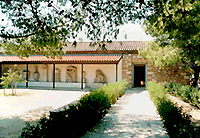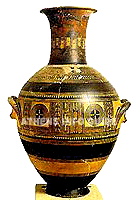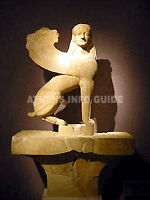
Kerameikos
Museum
The Kerameikos Museum was built in 1937 to the designs of H. Johannes
with funding of Gustav Oberlaender. Thanks to the financial support
of the Boeringer brothers, it was expanded in the 1960s.
The
museum houses findings from excavations in Kerameikos, mostly
objects directly connected to the cemetery and the burial
customs of ancient Athens such as funerary urns, grave offerings
as well as funerary monuments (stele). The latter, like the
inscribed reliefs, the loutrophoroi (a distinctive type of
Greek pottery characterized by its elongated neck that was
used to hold water during marriage and funeral rituals, and
was placed in the tombs of unmarried women.) dominate the
displays while exact casts can be seen on the site.
Excellent
examples of pottery can also be seen in the museum like an early
Geometric urn amphora (860-840 BC), the Amasis Lekythos with a
scene of the god Dionysus and two satyrs (mid-6th century BC),
the hydria by the painter Meidias with a multifigured scene etc.
Another
piece prominently displayed is the mid-6th century BC marble funerary
monument with a man carrying a stick and a sword as well as its
contemporary marble sphinx that funtioned as the crown of a funerary
momnument. Particularly remarcable among the funerary marble reliefs
are those of Ampharete in a scene with her grandchild (430-420
BC) and of Eukoline (380-370 BC) as well as the funerary monuments
of Eupheros (420 BC) and of Dexileos (394-393 BC).
The
first grave relief of the above was inscribed and in the epigram
of the epistyle, Ampharete mourns her own death and the death
of her daughter’s child which occurred at the same time.
On the relief of Eukoline, daughter of Antiphanes, the young woman
stares sadly at some object she holds in her hand (wich has not
survived). The relief is accompanied by an epigram which laments
the fate of the unfortunate girl.
The
relief stele of Euphoros was found on top of the grave with the
rich offerings of the young man, as if it too was burried, its
colors almost intact. The background of the relief decoration
was deep blue, the ribbon at his feet red and the hair bears traces
of yellow. It was set-up next to the modest stele of Lissos, the
brother of Eupheros.
 The
large monument of Dexileos, son of Lysanias from the deme of Thorikos,
was found when his father’s family grave was discovered.
The relief, standing on an inscribed base, depits the young man
as horseman and victor. However, according to the inscription,
the young warrior Dexileos was killed at the age of 20 during
a battle against the Corinthians in 394-393 BC. The
large monument of Dexileos, son of Lysanias from the deme of Thorikos,
was found when his father’s family grave was discovered.
The relief, standing on an inscribed base, depits the young man
as horseman and victor. However, according to the inscription,
the young warrior Dexileos was killed at the age of 20 during
a battle against the Corinthians in 394-393 BC.
His
monument looks towards the Dromos and the public cemetery of Athens
because Dexileios was burried in the Demosion Sema while the bones
of his brother Lysias and his sister Melitte were placed in his
cenotaph. Dexileios’s name is written on a marble stele
near the Demosion Sema with the names of the rest of his dead
comrades.
There
is a new exhibition of the most significant articles of the museum
that includes striking sculptures (kouros, sphinx) found in recent
excavations undertaken by the German Archaeological Institute.
You
are advised to visit the museum after your walk around the
archaeological site. 
 Opening hours and admission
Opening hours and admission
 148, Ermou Street - Kerameikos
148, Ermou Street - Kerameikos
 Kerameikos
Kerameikos
 For typical words, please consult our Greek
Glossary
For typical words, please consult our Greek
Glossary

|

